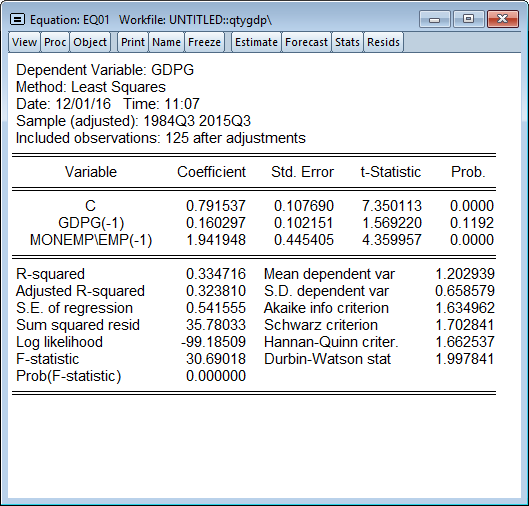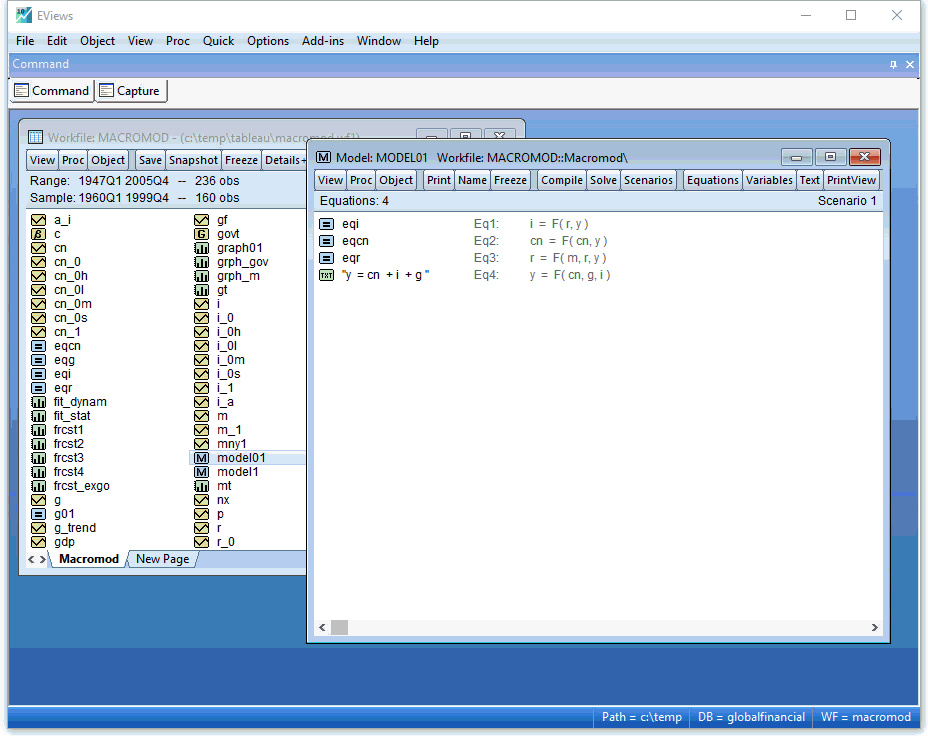
- #How to forecast in eviews how to#
- #How to forecast in eviews professional#
- #How to forecast in eviews series#
- #How to forecast in eviews simulator#
For institutions with a narrow geographic footprint, basing the qualitative overlays on the local, state or metropolitan area, rather than the national economic outlook, will capture the geography-specific risks and will make this approach more defensible. While the obvious benefit of this approach is its ease of implementation, the qualitative overlays will need to be defended before regulators and auditors. For example, an institution could simply qualitatively increase its historical vintage loss rates to account for higher expected unemployment rates during the remaining life of the loans on its books. In the simplest of approaches, institutions can use forward-looking information to adjust qualitatively their historical loss rates to obtain an estimate for lifetime expected loss. Including their respective costs and benefits Has an underlying narrative that allows noneconomists to understand both the rationaleīroadly speaking, an institution can account for the forward-looking view of the economy in its credit loss estimates in any Updates capture the latest historical dataĪnd incorporate the latest risks facing theĮconomy to ensure that forecasts are timelyĪnd reflect current conditions. Metropolitan-area levels, ensuring consistency between the Institutions will use in their CECL processes.įor example, Chart 1 shows the forecast of The distribution of these simulations provides a quantitative foundation to the projection of possible economic outcomes that Probabilities are derived from a simulation of Model (see Box 1 for a list of these scenarios). Rigorously validated structural econometric Produces a baseline and alternative forecasts With these requirements, Moody’s Analytics
#How to forecast in eviews professional#
Generated by internal teams or by researchĪgencies or professional forecasters, as longĪs the forecasts are defensible and consistent with the institution’s own views. With internal managements’ forward-lookingĪn institution can use economic forecasts We discuss the benefits and costs of each approach and provide practical recommendations based on institution size and complexity.ĬECL guidelines require that the economic forecasts that institutions use to estimate lifetime losses are not only consistent In this paper, we discuss some of the options that institutions have for incorporating economic forecasts into their expected loan loss reserve calculations. There are a number of ways in which this can be achieved, as the CECL guidelines do not specify one particular approach. In short, CECL will require institutions to incorporate macroeconomic forecasts formally into their loss allowance estimates for the first time. This requirement is a significant departure from the current “incurred loss” generally accepted accounting principles approach, which requires firms to wait until loans reach a probable threshold of loss before adding to their loss reserves. before and after the global financial crisis.CECL will require institutions to take into account reasonable and supportable forecasts as well as information from past events and current conditions. Module 8: Final Assignment: Bringing It All TogetherĪn overview of the techniques studied is provided using a case study focused on private saving-consumption behavior in the U.S. Introduction to model testing and dealing with error irregularities and structural breaks. What does it mean to have a “good model” (model evaluation and key model assumptions) and the consequences for forecasting.
#How to forecast in eviews how to#
Learn how to test for cointegration using the Johansen method and how to estimate and forecast using a VECM. Module 6: Cointegration and Vector Error Correction Models (VECMs)ĭefine and understand the concept of cointegration among unit-root variables and its implications for forecasting. Understand VARs, how they used for forecasting and structural analysis, and how to estimate a well-specified VAR and generate forecasts. Participants will learn the main forecast evaluation statistics and how to calculate them in EViews. How best to choose between forecasts from competing models or sources. Module 4: Forecast Uncertainty and Model Evaluation
#How to forecast in eviews series#
Box-Jenkins (ARMA) methodology to study time series is introduced. The concept of stationarity is defined as well as how to test for it. Module 3: Statistical Properties of Times Series Data

#How to forecast in eviews simulator#
Introduction to the EViews model simulator to estimate and forecast multiple equation models.

Module 2: Introduction to Forecasting with EViews

Review of the main EViews commands to manage data.


 0 kommentar(er)
0 kommentar(er)
